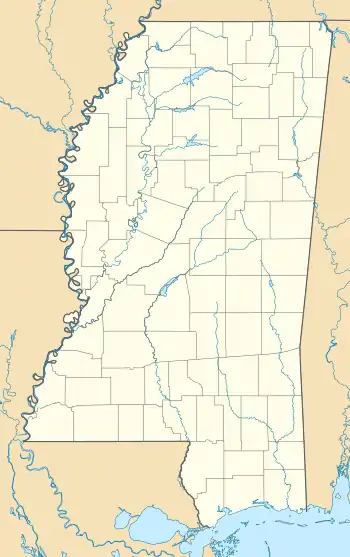Mound Landing, Mississippi | |
|---|---|
 Mound Landing, Mississippi Location within the state of Mississippi  Mound Landing, Mississippi Mound Landing, Mississippi (the United States) | |
| Coordinates: 33°36′26″N 91°07′37″W / 33.60722°N 91.12694°W | |
| Country | United States |
| State | Mississippi |
| County | Bolivar |
| Elevation | 135 ft (41 m) |
| Time zone | UTC-6 (Central (CST)) |
| • Summer (DST) | UTC-5 (CDT) |
| GNIS feature ID | 692087[1] |
Mound Landing is a ghost town in Bolivar County, Mississippi, United States.[1]
The settlement was located at Choctaw Bend on the Mississippi River.
History

The area was settled in 1840 by William P. Perkins, who used slave labor to clear 2,000 acres (810 ha) of canebrakes on which he established Mound Plantation, a cotton plantation.[2][3]
Mound Plantation and its river landing were named for three nearby Indian mounds.[2]
Perkins eventually owned 3,200 acres (1,300 ha) of land at the settlement and, by 1850, was Bolivar County's largest land owner and one of the United States' largest slaveholders.[3]
Mound Landing had a post office as early as 1880.[4]
In 1886, the population of Mound Landing was 50.[5]
A levee was erected in 1867 to protect the settlement from river flooding. The levee was locally financed, and subsequent improvements to the levee were made. A ferry landing was located at the settlement, with a ramp which permitted vehicles to pass over the top of the levee.[6]
In April 1927, as water levels on the Mississippi River began to rise due to heavy rains, an unknown number of Negro prisoners were brought in chains to Mound Landing by the National Guard to fill sandbags at gunpoint in an effort to reinforce the levee. On April 21, the levee at Mound Landing broke, killing at least 100 prisoners and carrying their bodies several miles from the settlement. The Great Mississippi Flood of 1927 was one of the most damaging floods in the United States, inundating 1,800 sq mi (4,700 km2) of land in the Mississippi Delta, taking 246 lives, and displacing 700,000 people.[7][8][9] A historic marker describing when "the Mississippi River broke the levee at Mound Landing" is located on Mississippi Highway 1, approximately 2.5 mi (4.0 km) east of the former settlement.[10]
All that remains at Mound Landing is a boatramp located on private property owned by a hunting club.[11]
Notable person
- J. E. Halbert, member of the Mississippi House of Representatives (1888–1889) and Surgeon General for Mississippi (1889–1892).[12]
References
- 1 2 "Mound Landing". Geographic Names Information System. United States Geological Survey, United States Department of the Interior.
- 1 2 Biographical and Historical Memoirs of Mississippi: Embracing an Authentic and Comprehensive Account of the Chief Events in the History of the State and a Record of the Lives of Many of the Most Worthy and Illustrious Families and Individuals. Goodspeed. 1891. pp. 586.
- 1 2 "Summary of "Wealth, Land and Slaveholding in Mississippi: A Planter Family's Life of Privilege, 1818–1913" by Ray R. Albin" (PDF). Santa Clara County Historical and Genealogical Society. Retrieved December 14, 2016.
- ↑ United States Official Postal Guide. United States Post Office. 1880. p. 98.
- ↑ Medical and Surgical Directory of the United States. Polk & Company. 1886. pp. 530.
- ↑ Bragg, Marion (1977). Historic Names and Places on the Lower Mississippi River (PDF). Mississippi River Commission. p. 123. Archived from the original (PDF) on March 4, 2016. Retrieved December 15, 2016.
- ↑ Tischauser, Leslie V. (2012). Jim Crow Laws. ABC-CLIO. p. 74. ISBN 9780313386091.
- ↑ Morris, Christopher (2012). The Big Muddy: An Environmental History of the Mississippi and Its Peoples from Hernando de Soto to Hurricane Katrina. Oxford University Press. ISBN 978-0-19-997706-2.
- ↑ "The State of Mississippi Standard Mitigation Plan" (PDF). Mississippi Emergency Management Agency. September 2010.
- ↑ Rogers, William. "Historical Markers in Bolivar County". William Rogers. Retrieved December 14, 2016.
- ↑ "Rosedale to Arkansas City". Rivergator. Retrieved December 14, 2016.
- ↑ The Transactions of the Third Annual Meeting of the Association of Military Surgeons, of the National Guard of the United States. Buxton and Skinner. 1894.
.jpg.webp)
